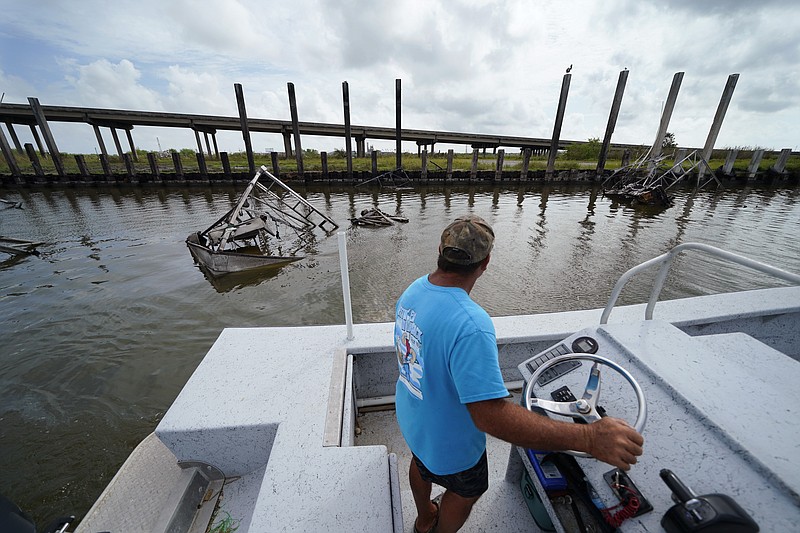Louisiana's oyster farmers, crabbers, shrimpers and anglers are nothing if not adaptable, producing millions of pounds of seafood annually, often in water that was dry land a generation ago. They've fought off a devastating oil spill, floods, changing markets and endless hurricanes just to stay in business.
After Hurricane Ida, though, some wonder about their ability to continue in a seemingly endless cycle of recovery and readjustment.
The Category 4 hurricane that struck Louisiana late last month fractured some parts of the industry even worse than 2005's Katrina, which cost seafood businesses more than $1 billion. No one yet knows how many boats, docks and processors were lost because of Ida's relentless, 150-mph winds. Vessels that made it to the safest harbors fared the best, yet even some of them were destroyed by the storm's fury.
Lt. Gov. Billy Nungesser, whose office oversees seafood promotion, said some areas, like Lafitte, were all but wiped out. The damage is a devastating blow to people whose entire lives are intertwined with fishing and the Gulf Coast.
"This thing just seemed to beat and beat and beat, kind of mixing it up like a washing machine," Nungesser said. "I think that slow-moving storm beating these boats against the docks, against each other, caused a lot more vessels to sink and have major damage."
The story of Ida's impact on Louisiana's $2.4 billion seafood industry, which employs more than 23,000 at last count, is unfolding across places that outsiders struggle to even pronounce: Parishes like Plaquemines, Lafourche, and Terrebonne, cities and hamlets including Pointe-aux-Chenes, Des Allemandes and Houma. There, seafood families go back generations.
The people who make their living off the Gulf bounty are pledging to come back again this time provided another hurricane doesn't wipe them out first. But there are other challenges ahead as Louisiana tries to save a vanishing coastline, an industry and a way of life, all at the same time.
The ferocious wind from Hurricane Ida tore off so much of the roof of Motivatit Seafoods that it rained inside the oyster plant in Houma when squalls from Hurricane Nicholas blew through two weeks later, ruining expensive processing equipment. Across a parking lot, Ida reduced the company's maintenance shop to a crumpled heap of metal.
"This is at least 20 times worse than we've ever had," said Steven Voisin, who runs the 50-year-old family business founded by his late brother and father. "It could have been worse, but it doesn't matter. The buildings are to the extent of not really being able to be reused."
Oyster production already was down in Louisiana because of hurricanes and the BP oil spill of 2010, and several years of bad flooding virtually wiped out some areas where the shellfish grew, partly because a major spillway had to be opened in 2019, Voisin said.
"Where this state was out-producing all other states combined in the past, now we're just another state with a few oysters," he said.
Then, the coronavirus pandemic forced restaurants around the U.S. to close last year, killing demand for a product that's best served fresh. While Motivatit Seafoods employed as many as 100 people in the past, Voisin said, the current payroll is around 20 people, at least some of whom will help determine how to move forward after Ida.
"We're going to have to consolidate things, become smaller, use what we can and hope to get up and running," he said.
Voisin said he has yet to compute a dollar estimate for damage to the company, which also operates boats that harvest oysters, but it's substantial.
"We hope that we're able to have the vision and the wisdom to continue. It's going to be a battle," he said.
About half the shrimping fleet was destroyed by Ida in some coastal parishes, Acy Cooper, president of the Louisiana Shrimp Association, said. That amounts to hundreds of boats.
"It's going to be devastating for the industry," Cooper said. "Every (boat) is a small business you're losing."
Even shrimp boats that weren't damaged couldn't fish for days after Ida because of the lack of power and clean water needed to make ice, which is vital to storing the catch, he said. A day at the dock means a day without income, which hurts in an industry already buffeted by years of foreign imports, high fuel prices, shifting demand and more.
"The industry is going to take a big hit here," said Cooper.
